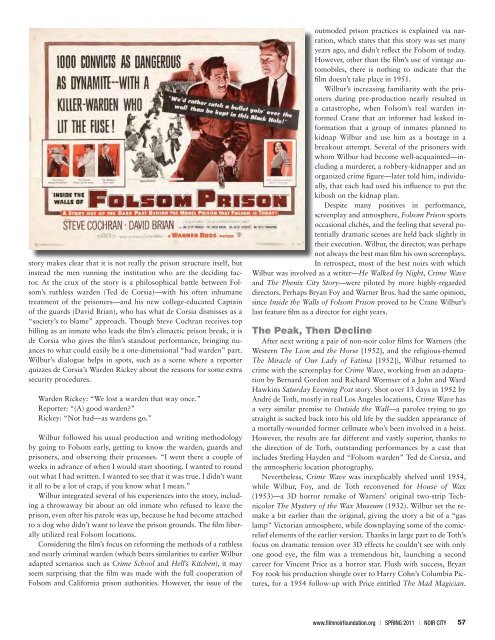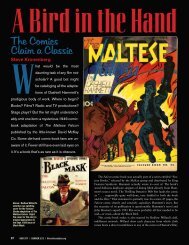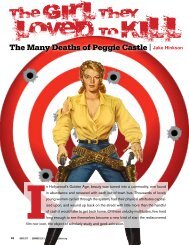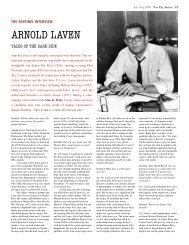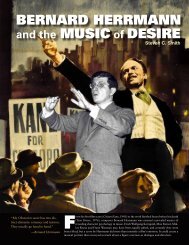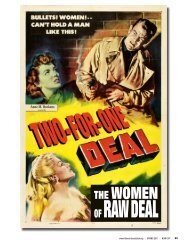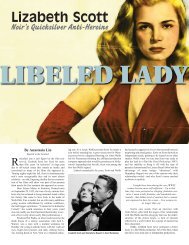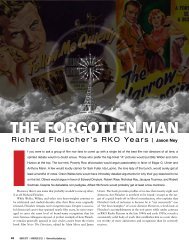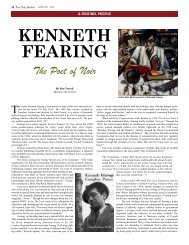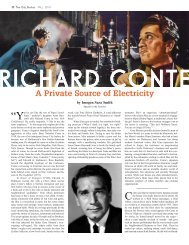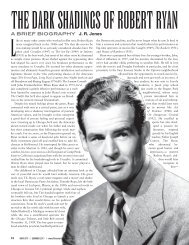Crane Wilbur - Film Noir Foundation
Crane Wilbur - Film Noir Foundation
Crane Wilbur - Film Noir Foundation
You also want an ePaper? Increase the reach of your titles
YUMPU automatically turns print PDFs into web optimized ePapers that Google loves.
story makes clear that it is not really the prison structure itself, but<br />
instead the men running the institution who are the deciding factor.<br />
At the crux of the story is a philosophical battle between Folsom’s<br />
ruthless warden (Ted de Corsia)—with his often inhumane<br />
treatment of the prisoners—and his new college-educated Captain<br />
of the guards (David Brian), who has what de Corsia dismisses as a<br />
“society’s to blame” approach. Though Steve Cochran receives top<br />
billing as an inmate who leads the film’s climactic prison break, it is<br />
de Corsia who gives the film’s standout performance, bringing nuances<br />
to what could easily be a one-dimensional “bad warden” part.<br />
<strong>Wilbur</strong>’s dialogue helps in spots, such as a scene where a reporter<br />
quizzes de Corsia’s Warden Rickey about the reasons for some extra<br />
security procedures.<br />
Warden Rickey: “We lost a warden that way once.”<br />
Reporter: “(A) good warden?”<br />
Rickey: “Not bad—as wardens go.”<br />
<strong>Wilbur</strong> followed his usual production and writing methodology<br />
by going to Folsom early, getting to know the warden, guards and<br />
prisoners, and observing their processes. “I went there a couple of<br />
weeks in advance of when I would start shooting. I wanted to round<br />
out what I had written. I wanted to see that it was true. I didn’t want<br />
it all to be a lot of crap, if you know what I mean.”<br />
<strong>Wilbur</strong> integrated several of his experiences into the story, including<br />
a throwaway bit about an old inmate who refused to leave the<br />
prison, even after his parole was up, because he had become attached<br />
to a dog who didn’t want to leave the prison grounds. The film liberally<br />
utilized real Folsom locations.<br />
Considering the film’s focus on reforming the methods of a ruthless<br />
and nearly criminal warden (which bears similarities to earlier <strong>Wilbur</strong><br />
adapted scenarios such as Crime School and Hell’s Kitchen), it may<br />
seem surprising that the film was made with the full cooperation of<br />
Folsom and California prison authorities. However, the issue of the<br />
outmoded prison practices is explained via narration,<br />
which states that this story was set many<br />
years ago, and didn’t reflect the Folsom of today.<br />
However, other than the film’s use of vintage automobiles,<br />
there is nothing to indicate that the<br />
film doesn’t take place in 1951.<br />
<strong>Wilbur</strong>’s increasing familiarity with the prisoners<br />
during pre-production nearly resulted in<br />
a catastrophe, when Folsom’s real warden informed<br />
<strong>Crane</strong> that an informer had leaked information<br />
that a group of inmates planned to<br />
kidnap <strong>Wilbur</strong> and use him as a hostage in a<br />
breakout attempt. Several of the prisoners with<br />
whom <strong>Wilbur</strong> had become well-acquainted—including<br />
a murderer, a robbery-kidnapper and an<br />
organized crime figure—later told him, individually,<br />
that each had used his influence to put the<br />
kibosh on the kidnap plan.<br />
Despite many positives in performance,<br />
screenplay and atmosphere, Folsom Prison sports<br />
occasional clichés, and the feeling that several potentially<br />
dramatic scenes are held back slightly in<br />
their execution. <strong>Wilbur</strong>, the director, was perhaps<br />
not always the best man film his own screenplays.<br />
In retrospect, most of the best noirs with which<br />
<strong>Wilbur</strong> was involved as a writer—He Walked by Night, Crime Wave<br />
and The Phenix City Story—were piloted by more highly-regarded<br />
directors. Perhaps Bryan Foy and Warner Bros. had the same opinion,<br />
since Inside the Walls of Folsom Prison proved to be <strong>Crane</strong> <strong>Wilbur</strong>’s<br />
last feature film as a director for eight years.<br />
The Peak, Then Decline<br />
After next writing a pair of non-noir color films for Warners (the<br />
Western The Lion and the Horse [1952], and the religious-themed<br />
The Miracle of Our Lady of Fatima [1952]), <strong>Wilbur</strong> returned to<br />
crime with the screenplay for Crime Wave, working from an adaptation<br />
by Bernard Gordon and Richard Wormser of a John and Ward<br />
Hawkins Saturday Evening Post story. Shot over 13 days in 1952 by<br />
André de Toth, mostly in real Los Angeles locations, Crime Wave has<br />
a very similar premise to Outside the Wall—a parolee trying to go<br />
straight is sucked back into his old life by the sudden appearance of<br />
a mortally-wounded former cellmate who’s been involved in a heist.<br />
However, the results are far different and vastly superior, thanks to<br />
the direction of de Toth, outstanding performances by a cast that<br />
includes Sterling Hayden and “Folsom warden” Ted de Corsia, and<br />
the atmospheric location photography.<br />
Nevertheless, Crime Wave was inexplicably shelved until 1954,<br />
while <strong>Wilbur</strong>, Foy, and de Toth reconvened for House of Wax<br />
(1953)—a 3D horror remake of Warners’ original two-strip Technicolor<br />
The Mystery of the Wax Museum (1932). <strong>Wilbur</strong> set the remake<br />
a bit earlier than the original, giving the story a bit of a “gas<br />
lamp” Victorian atmosphere, while downplaying some of the comicrelief<br />
elements of the earlier version. Thanks in large part to de Toth’s<br />
focus on dramatic tension over 3D effects he couldn’t see with only<br />
one good eye, the film was a tremendous hit, launching a second<br />
career for Vincent Price as a horror star. Flush with success, Bryan<br />
Foy took his production shingle over to Harry Cohn’s Columbia Pictures,<br />
for a 1954 follow-up with Price entitled The Mad Magician.<br />
www.filmnoirfoundation.org i SPrinG 2011 i noir citY 57


